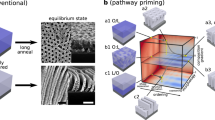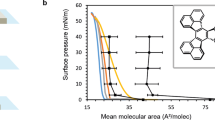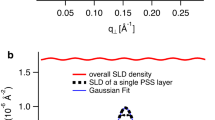Abstract
MOLECULAR films with predetermined layered structures can be engineered by using techniques such as the Langmuir–Blodgett method1,2 and self-assembly1,3–9 to deposit discrete monolayers sequentially on a substrate. Such films might have a variety of uses—as smart surface coatings, nonlinear optical materials and in tribology, for example. Here we report the replicative growth of a molecular film of self-assembling silane bilayers with hydrogen-interlayer polar regions into which further identical bilayers can be intercalated. The intercalation step is triggered by a chemical treatment and so can be carried out controllably, allowing duplication in one step of an entire multilayer structure. In this way, we can achieve the stepwise exponential growth of a multilayer film with a predictable number of stacked bilayers.
This is a preview of subscription content, access via your institution
Access options
Subscribe to this journal
Receive 51 print issues and online access
$199.00 per year
only $3.90 per issue
Buy this article
- Purchase on Springer Link
- Instant access to full article PDF
Prices may be subject to local taxes which are calculated during checkout
Similar content being viewed by others
References
Ulman, A. An Introduction to Ultrathin Organic Films From Langmuir-Blodgett to Self-Assembly (Academic, Boston, 1991).
Kuhn, H. & Möbius, D. in Physical Methods of Chemistry (eds Rossiter, B. W. & Baetzold, R. C.) 375–542 (Wiley, New York, 1993).
Maoz, R., Netzer, L., Gun, J. & Sagiv, J. J. Chim. Phys. 85, 1059–1065 (1988).
Keller, S. W., Kim, H.-N. & Mallouk, T. E. J. Am. Chem. Soc. 116, 8817–8818 (1994).
Thompson, M. E. Chem. Mater. 6, 1168–1175 (1994).
Byrd, H. et al. J. Am. Chem. Soc. 116, 295–301 (1994).
Decher, G., Hong, J.-D., Lowack, K., Lvov, Y. & Schmitt, J. in Self-Production of Supramolecular Structures From Synthetic Structures to Models of Minimal Living Systems (eds Fleischaker, G. R., Colonna, S. & Luisi, P. L.) 267–272 (NATO ASI Ser. C. Vol. 446, Kluwer Academic, Dordrecht, 1994).
Li, D.-Q. et al. J. Am. Chem. Soc. 112, 7389–7390 (1990).
Ogawa, K., Mino, N., Tamura, H. & Hatada, M. Langmuir 6, 851–856 (1990).
Cairns-Smith, A. G. Genetic Takeover and the Mineral Origins of Life (Cambridge Univ. Press, 1982).
Orgel, L. E. Nature 358, 203–209 (1992).
Self-Production of Supramolecular Structures From Synthetic Structures to Models of Minimal Living Systems (eds Fleischaker, G. R., Colonna, S. & Luisi, P. L) (NATO ASI Ser. C. Vol. 446, Kluwer Academic, Dordrecht, 1994).
Kuhn, H. & Waser, J. in The Lock-and-Key Principle The State of the Art—100 Years On (ed. Behr, J.–P.) 247–306 (Wiley, Chichester, 1994).
Lehn, J.-M. Angew. Chem. Int. Edn. Engl. 29, 1304–1319 (1990).
Whitesides, G. M., Mathias, J. P. & Seto, C. T. Science 254, 1312–1319 (1991).
Müller, W. et al. Science 262, 1706–1708 (1993).
Fuhrhop, J.-H. & Krull, M. in Frontiers in Supramolecular Organic Chemistry and Photochemistry (eds Schneider, H.-J. & Dürr, H.) 223–249 (VCH, Weinheim, 1991).
Ozin, G. A. Adv. Mater. 4, 612–649 (1992).
Maoz, R., Yam, R., Berkovic, G. & Sagiv, J. in Thin Films Vol. 20 (ed. Ulman, A.) 41–68 (Academic, San Diego, 1995).
Maoz, R., Sagiv, J., Degenhardt, D., Möohwald, H. & Quint, P. Supramol. Sci. 2, 9–24 (1995).
Casal, H., Cameron, D. G. & Mantsch, H. Can. J. Chem. 61, 1736–1742 (1983).
Jones, R. N., McKay, A. F. & Sinclair, R. G. J. Am. Chem. Soc. 74, 2575–2578 (1952).
Nuzzo, R. G., Dubois, L. H. & Allara, D. L. J. Am. Chem. Soc. 112, 558–569 (1990).
Andrianov, K. A. & Izmaylov, B. A. J. Organomet. Chem. 8, 435–450 (1967).
Maoz, R. & Sagiv, J. J. Colloid Interface Sci. 100, 465–496 (1984).
Parikh, A. N., Allara, D. L., Ben Azouz, I. & Rondelez, F. J. Phys. Chem. 98, 7577–7590 (1994).
Weiss, A. Angew. Chem. Int. Edn Engl. 20, 850–860 (1981).
Bachmann, P. A., Luisi, P. L. & Lang, J. Nature 357, 57–59 (1992).
Fleischaker, G. R. in Self-Production of Supramolecular Structures From Synthetic Structures to Models of Minimal Living Systems (eds Fleischaker, G. R., Colonna, S. & Luisi, P. L.) 33–41 (NATO ASI ser. C. Vol. 446, Kluwer Academic, Dordrecht, 1994).
Author information
Authors and Affiliations
Rights and permissions
About this article
Cite this article
Maoz, R., Matlis, S., DiMasi, E. et al. Self-replicating amphiphilic monolayers. Nature 384, 150–153 (1996). https://doi.org/10.1038/384150a0
Received:
Accepted:
Issue Date:
DOI: https://doi.org/10.1038/384150a0
This article is cited by
-
Single-layer ionic conduction on carboxyl-terminated silane monolayers patterned by constructive lithography
Nature Materials (2015)
-
Silicon Based Nanocoatings on Metal Alloys and Their Role in Surface Engineering
Silicon (2010)
-
Formation of hybrid nano-crystals in organic–inorganic films from a basic sol
Journal of Sol-Gel Science and Technology (2009)
-
Self-assembly of the 3-aminopropyltrimethoxysilane multilayers on Si and hysteretic current–voltage characteristics
Applied Physics A (2008)
-
Stabilizing a solid–solid interface with a molecular-scale adhesive
Nature (1999)
Comments
By submitting a comment you agree to abide by our Terms and Community Guidelines. If you find something abusive or that does not comply with our terms or guidelines please flag it as inappropriate.



